In continuation with our beautiful stuff project, the children used real wood piece to create home, buildings, bridges and other various structures. The children created, draw their designs, labelled some parts, glued and painted their designs. It was a great and fun experience.
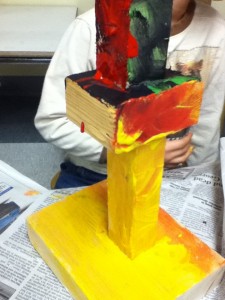
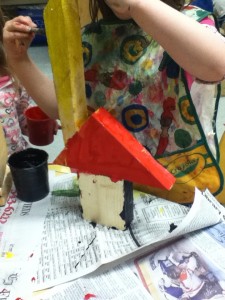
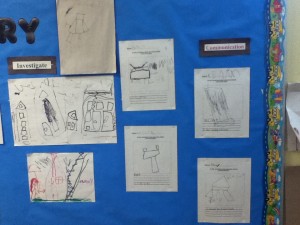

 This student independently drew a picture of his neighbourhood when we were writing in our journals. He carefully selected shapes that are parts of a building, told me about the buildings-some stores and houses and added stairs that go to the bed on the top floor (blueprints show stairs!).
This student independently drew a picture of his neighbourhood when we were writing in our journals. He carefully selected shapes that are parts of a building, told me about the buildings-some stores and houses and added stairs that go to the bed on the top floor (blueprints show stairs!).
Here is a great website from the research project in Reggio schools in Italy. There is some great information and pictures about documentation.
Main Page that will tell you about the project http://www.mlvpz.org/index.html
Documentation samples http://www.mlvpz.org/documentation/index.html
Planning with the end task in mind, deciding how you will assess your students, and what they need to know are many questions teachers ask themselves when planning lessons and units of study. Backwards planning is what it is. We work from our overall and specific expectations, think about the ’big idea” or our learning goal(s) for the activities that we have planned out. This thinking will give you a clear idea of where you need to start and it keeps us focused. Now, plan for the final product or the summative task. This could be giving an authentic questions if it is math related, a response to a reading strategy you are working on…etc.
When we begin working on a new unit of study we need to collect information to see where students are at so we can plan what we need to teach.
Diagnostic Assessment is a ”pre” task that will give you an idea of what students know or not, before you get started. Example:
Teachers can choose the assessment tools they need to collect, organize, and record information about the student learning during the unit. It is also the informal times that we may see learning. So choosing how that will be captured-camera, recorder etc. may be an alternate form of assessment to keep on hand.
Assessment as Learning is the ongoing monitoring of student progress, allowing for feedback, changes/tweaking, and adjustments or whatever is needed to give the students a clear understand of how they can improve. Example: This can be done in small group, with descriptive feedback, conferences, written exchange of dialogue, oral conversations, etc. This may be a time when the teacher needs to provide mini-lessons to fill the gaps in learning to make the students successful.
Here is a link to an article on formative assessment http://earlylearningcentral.ca/wp-content/uploads/2009/02/Research-for-Teachers-Number-2-Formative-Assessment-article-nov-2010.pdf. Formative assessment assists students making them successful by giving suggestions for improving learning rather then just judging.
Summative Assessment is the final task at the end of the unit where students show their final learning. This can take a variety of forms and should allow for students to show their learning from a variety of tasks. Some students may want to choose to illustrate their learning through a visual-drawing, artwork. Some may need to display in an oral conversation, a play etc. Giving students different assessment strategies based on their learning styles and needs, will engage students and give them other options to display their learning.
Here is a full link on ELC around assessment http://earlylearningcentral.ca/?page_id=2234
When creating centres in the primary grades they need to be inviting, allow for multiple students to be engaged, and connect to the curriculum or big idea (purposeful!).
Primarily Play Document provides some great examples of how to start and extend inquiry ideas that can connect to the curriculum expectations as well as some examples of what it could look like in the classroom. http://earlylearningcentral.ca/wp-content/uploads/2009/02/PP-57-59.pdf
http://earlylearningcentral.ca/wp-content/uploads/2011/08/newlookplay.pdf
In this JK/SK classroom the children are interested in music. As the Teacher and ECE partner worked in various ways with students around the classroom, this became a more apparent topic worthy of more study. They both worked together collaborating on how to bring this study to fruition for the students.
In this display, children worked in large group creating a KWL chart, identified some new vocabulary, and had guest speakers come in to show their talents! Each student create an instrument that they were interested in and they are displayed for all to see on the table. The final piece is where each student communicated what new information they learned through the inquiry and how they changed as a researcher. This information will be inserted into their documentation binders.
Focusing on the classroom environment is important in engaging students. It tells them what is valued, what is important in learning and it will certainly set a tone for learning. As I return to my classroom I am reflecting on what has worked and what hasn’t and other ways I can give students opportunities to learn new things.
For example, more computer access to seek information on our inquiry projects, adding mirrors to our light table area, looking at my shelving space and how I can organized various materials to make things more appealing to my students, and creating more centres of inquiry. With all this happening, how can I better assess my students through documentation. I created a new form that my ECE partner and I can track conversations in a more organized fashion and we can simply slip the forms into portfolios as opposed to always typing the information out. I also gathered more clipboards to have at each station and labelled these as our documentation boards.
Here are a few photos of centre idea where children can be creative.
This is a great little centre that focuses around found materials. Students can develop their fine motor skills in connection to math or art. The mats are earth tone in colour and are used as a different surface for children to create.
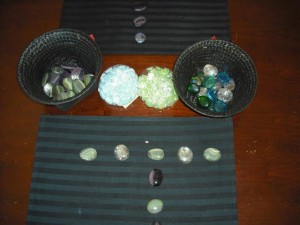 This centre idea uses material found at the dollar store. There are jewels and stones of different colours that you can place in different baskets sorted by colour/shapes/size its up to you. You can use placemats, black felt, photo frames that students can use to display their different art pieces. Again, you can connect to math and a great oral language opportunity for the children.
This centre idea uses material found at the dollar store. There are jewels and stones of different colours that you can place in different baskets sorted by colour/shapes/size its up to you. You can use placemats, black felt, photo frames that students can use to display their different art pieces. Again, you can connect to math and a great oral language opportunity for the children.
Here are some pictures of one environment http://earlylearningcentral.ca/?page_id=2138 to get you thinking about your space. Reflective Questions: What do you do when the environment is not working for your students? How can you place materials that will engage student learning? How can I document student learning and display it?
Today I had an opportunity to read through some research on why documentation is important to student learning. In the attached article http://www.edu.gov.on.ca/eng/literacynumeracy/inspire/research/CBS_Pedagogical.pdf there is some great reference points about how students learn and think and how we as teachers extend our understanding of documentation as we discuss, share and collaborate with colleagues. Another topic that was interesting was peer feedback. I tried this informally late last year and when I felt they were ready. I also tried a form of strengths and next steps (one star, one wish) in my literacy assessment. It was a great opportunity to have a conversation about the student work. Again, I did this in late February. I was amazed at how they were able to share not only what they are good at, but where they need to improve!!
Another important part that stood out the most for me was the accountability. We are constantly defending the play-based learning approach to parents, the public and what better way to display learning through prompts, pictures, and questioning. Display student work with their dialogue, questioning. Have their portfolios out and accessible for them to refer back to, display learning over time–history from previous years. Create a communication board on inquiry and show students engaged in learning! Have a read and enjoy!




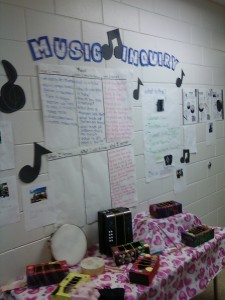

Recent Comments